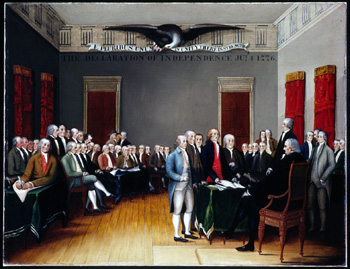Revolutions in Government

On August 23, 1775, George III declared the American colonies in "open and avowed rebellion" and that "they must either submit or triumph." Four months later, on December 22, Parliament declared the American colonies beyond its protection. By the beginning of 1776, what John Adams would later call "thirteen revolutions in civil government" began in earnest to repudiate the authority of Britain. New Hampshire adopted a new constitution on January 5, 1776, followed by South Carolina on March 26, Georgia on April 15, Rhode Island on May 4, and North Carolina on May 11.
By the end of 1776, each if the colonies had new governments—a transition that was mirrored on a national level. On April 12, 1776, North Carolina was the first colony to instruct its delegates to the Second Continental Congress to vote for full independence from Britain, followed by Virginia on May 15. Virginia's Richard Henry Lee formally proposed political independence from Britain to the assembled Continental Congress delegates in Philadelphia on June 7. Several colonies threatened to withdraw. Both Maryland and New Jersey, for example, strongly opposed independence.
The Congress agreed to postpone the vote on Lee's resolution until early July to give time for a committee to draft a declaration of independence setting out the reasons for the step and another committee to begin work on the framework for a new national government. On July 2 the Congress unanimously voted for independence (New York abstained, courteously). John Adams wrote to his wife the next day that it would "be the most memorable epoch in the history of America," to be "celebrated by succeeding generations as the great anniversary festival." After altering the text in important ways, the Congress adopted Thomas Jefferson's Declaration of Independence on July 4. On July 12, the other committee at work introduced its Articles of Confederation, which would finally be adopted as the national government in November 1777.










